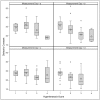Sensor-Based Detection of the Severity of Hyperkeratosis in the Teats of Dairy Cows
- PMID: 30441773
- PMCID: PMC6263564
- DOI: 10.3390/s18113925
Sensor-Based Detection of the Severity of Hyperkeratosis in the Teats of Dairy Cows
Abstract
The aim of this study was to evaluate whether the severity of hyperkeratosis (HK) in the teats of dairy cows can be assessed by a dielectric measurement. The study focused on surveying the occurrence of hyperkeratosis in a total of 241 teats of lactating dairy cows. A scoring system consisting of four categories was used to macroscopically assess the severity of HK. Additionally, the dielectric constant (DC) of all teats with milkability was measured in a double iteration with the MoistureMeterD (Delfin Technologies, Kuopio, Finland) on four different days. The Spearman rank correlation coefficient revealed a negative correlation between the DC and HK score (rs = -0.55 to -0.36). The results of the regression analysis showed that the DC values differed significantly between healthy teat ends (≤2) and teat ends with HK (≥3). Thus, the non-invasive measurement of DC provides a promising method of objectively assessing the occurrence and severity of HK.
Keywords: dairy cow; dielectric constant; sensor; teat end hyperkeratosis; water content.
Conflict of interest statement
The authors declare no conflict of interest.
Figures




Similar articles
-
Anatomical characteristics of teats and premilking bacterial counts of teat skin swabs of primiparous cows exposed to different types of bedding.J Dairy Sci. 2017 Feb;100(2):1436-1444. doi: 10.3168/jds.2016-11514. Epub 2016 Dec 9. J Dairy Sci. 2017. PMID: 27939553 Clinical Trial.
-
Changes in teat-end hyperkeratosis after installation of an individual quarter pulsation milking system.J Dairy Sci. 2013 Jun;96(6):4041-6. doi: 10.3168/jds.2012-6069. Epub 2013 Apr 12. J Dairy Sci. 2013. PMID: 23587374
-
Short communication: Pre- and postmilking anatomical characteristics of teats and their associations with risk of clinical mastitis in dairy cows.J Dairy Sci. 2016 Oct;99(10):8323-8329. doi: 10.3168/jds.2015-10093. Epub 2016 Jul 27. J Dairy Sci. 2016. PMID: 27474978
-
Associations between teat injuries and fistula formation in lactating dairy cows treated with surgery.J Am Vet Med Assoc. 2007 Dec 1;231(11):1704-8. doi: 10.2460/javma.231.11.1704. J Am Vet Med Assoc. 2007. PMID: 18052808
-
Short communication: Teat skin pH.J Dairy Sci. 2003 Dec;86(12):3951-2. doi: 10.3168/jds.S0022-0302(03)74004-1. J Dairy Sci. 2003. PMID: 14740831 Review.
Cited by
-
Assessment of feeding, ruminating and locomotion behaviors in dairy cows around calving - a retrospective clinical study to early detect spontaneous disease appearance.PLoS One. 2022 Mar 4;17(3):e0264834. doi: 10.1371/journal.pone.0264834. eCollection 2022. PLoS One. 2022. PMID: 35245319 Free PMC article.
References
-
- Gleeson D.E., O’Callaghan E.J., Rath M. The effects of genotype, milking time and teat-end vacuum pattern on the severity of teat-end hyperkeratosis. Irish J. Agric. Food Res. 2003;42:195–203.
-
- Neijenhuis F., Mein G.A., Reinemann D.J. Evaluation of bovine teat condition in commercial dairy herds: 4. Relationship between teat-end callosity or hyperkeratosis and mastitis; Proceedings of the AABP-NMC International Symposium on Mastitis and Milk Quality; Vancouver, BC, Canada. 13–15 September 2001; pp. 362–366.
-
- Singh V., Singh V.K., Doley P., Singh A. Association between teat condition score and udder health status in dairy bovines. J. Agric. Vet. Sci. 2014;7:9–11. doi: 10.9790/2380-07510911. - DOI
MeSH terms
LinkOut - more resources
Full Text Sources

